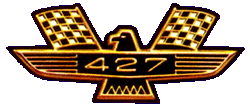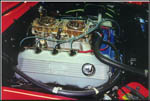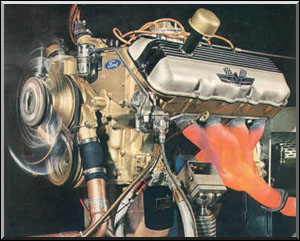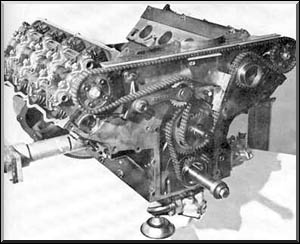I was introduced to Fords at a very early age. In fact when I was born, I was brought home in a 1941 Ford 2 door my parents owned at the time. That was in 1947. My father was the service manager at the local Ford dealer, so Fords were pretty much all we ever owned.
In 1970 1 bought a '69 Boss 302 Mustang from my brother. I drove it on the street during the week, and auto crossed it on weekends. Eventually the engine couldn't stand the stress any more and blew up. As luck would have it, a friend of mine had his '63½ 'R' code Galaxie 500-XL for sale. I bought it for $850. 1 drove that car for a while, but the urge to mate the 427 to the Mustang was to great to resist. Having done that, I sold the Galaxie. Eventually I decided to turn the Mustang into a drag race car. I did pretty well ' bracket ' racing it at the local drag strips. It ran mid I I's at 118 to 120 mph. Of course you can never go too fast. So in 1975 when I had the opportunity to buy a SOHC 427 for $14009 1 jumped at it. For those who don't know what a SOHC 427 is, it is an engine that was built by Ford in 1965-1966 for their NASCAR program as an answer to the Chrysler "Hemi". It is a true hemispherical head engine with chain driven overhead cams, one cam per head. With two 4 barrel carburetors, it was factory rated at 616 horsepower at 7000 RPM. It is a very rare engine. Less than 500 were built before NASCAR outlawed them. The few that were built were sold over the counter mainly to the top drag racers of the time. I bought mine from a fellow who had it in a drag boat. My plan was to put that motor in the Mustang, but due to rule changes, I was financially forced to quit drag racing. The motor went into storage and the Mustang was sold.
In 1990 1 decided it was time to do something with the SOHC motor. I saw an issue of Super Ford magazine that featured a 1961 Starliner powered by a SOHC 427. 1 was amazed at how easy the owner said it was to put the engine in his car. I started looking in the classified ads for a Galaxie to put my engine in. I found a yellow '64 XL with white interior for $500. It was in pretty bad shape, but fairly complete, so I bought it. I decided to do a body off restoration.
I completely disassembled the car, and had the frame and all it's components powder coated. I reassembled the chassis using all new brake and suspension parts. I found a pair of rear leaf springs from a '63 station wagon and removed I leaf. I also cut I coil from each of the front springs to give the car a slight nose down attitude. I installed KYB gas shocks, and bolted on a set of American Torque Thrust "D" spoke mags, 15 x 7 front and 15 x 8 ½ rear.
Next I put the engine and transmission in place. The transmission is a B&M C-6 with a manual shift valve body and a reversed shift pattern. Since exhaust manifolds do not exist for SOHC motors, I had to build my own headers. That sure was a lot easier with the body off. With the chassis complete, my friends and I sat the body back on and sent the car off to the body shop.
The body was stripped, straightened (some panels replaced), and repainted. I chose GM bright red. It was a little over a year before I got it back from the body shop. In the meantime I had the seats rebuilt and upholstered in black vinyl with velour inserts. I found a donor car with black interior and got the door and quarter panels from it. I called Greg Donahue and ordered new weather stripping, a new trunk mat, battery tray and headliner. Crites supplied the reproduction package tray. With all the parts gathered up, final assembly began.
I started with the outside trim. When I got to the front fender moldings, I noticed that it said Galaxie 500 and not Galaxie 500-XL. So I called Greg Donahue again to get the correct trim. He said that all he had was a pair of NOS fender moldings for $750. Not wanting to spend that much, I decided that if the moldings couldn't say XL, then they wouldn't say anything. So I removed the script, molded in the holes, and repainted them. I finished the rest of the outside trim and installed the interior. Finally the project is done, right? Wrong! I started the engine and clouds of white smoke appear (coolant in two of the cylinders). Out comes the engine. Cracked block. Car sits.
Now it's 1999. 1 find another block, have it bored .030 over and order a custom set of 10 to 1 pistons from Arias. While I'm at it I install Dove stainless steel valves, bronze valve guides, and aluminum water pump. I also use ARP main and rod bolts, and Milodon 7 quart pan and pickup tube. I updated the fuel system with a Holley fuel pump and regulator, Fram remote mount fuel filter, and Russell ½ inch aluminum fuel line. I replaced the stock dual point distributor with a Mallory Unilite electronic unit. The last thing to do is the exhaust system. My friend at the local muffler shop shows the car to his distributor and he donates a pair of Allied "Mean Streak" mufflers. Then my friend says he will donate the rest of the exhaust system (3 inch aluminized tubing) if I will bring the car to his annual car show and let him put it on his lift so he can show off his work. Gee twist my arm!
This time for sure the project is done. Well I guess they're never really done. Some of the outside trim needs to be replaced, and the gage bezels need to be rechromed, etc., but at least now I can drive it. Rich Perry
Sonoma, California
SOHC 427
autorich1@aol.com |
